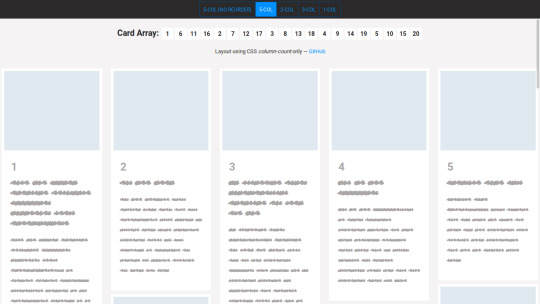#Weissenberg effect
Explore tagged Tumblr posts
Text
Explore 15+ CSS Masonry Layout Examples

Welcome to CSS Monster, your go-to destination for exploring our updated collection of HTML and CSS masonry layout code examples. Freshly curated in May 2021, this collection introduces four new items, carefully sourced from platforms like CodePen, GitHub, and other reputable resources. Masonry layouts, inspired by the construction technique of laying bricks without gaps, have become a go-to choice for presenting images and diverse content on the web. Similar to their namesake, masonry layouts organize elements of varying heights into a visually pleasing, gap-free structure. Within this collection, diversity takes center stage. We've curated a range of masonry layout designs that cater to different needs and aesthetics. From straightforward image galleries to intricate web pages featuring text and multimedia content, there's something to capture the imagination of every designer. Each item in this collection stands out for its design quality and functionality. Built using HTML and CSS, these masonry layouts are not only visually appealing but also seamlessly integrable into your projects. And the best part? They come with the freedom to use them for free! Whether you're a seasoned developer seeking inspiration or a beginner eager to learn from practical examples, this collection serves as an invaluable resource. Dive into the world of masonry layout code examples, and you might just discover the perfect design for your next project. CSS Monster is your gateway to a realm of creative possibilities in web development. Explore, experiment, and elevate your projects with these dynamic masonry layouts!

Author Saief Al Emon May 4, 2020 Links Just Get The Demo Link How To Download - Article How To Download - Video Made with HTML / CSS About a code CSS GRID: RESPONSIVE MASONRY LAYOUT Compatible browsers:Chrome, Edge, Firefox, Opera, Safari Responsive:yes Dependencies:-

Author Jen Simmons April 30, 2020 Links Just Get The Demo Link How To Download - Article How To Download - Video Made with HTML / CSS About a code MASONRY-STYLE LAYOUT Compatible browsers:Chrome, Edge, Firefox, Opera, Safari Responsive:yes Dependencies:-

Author Madalena February 29, 2020 Links Just Get The Demo Link How To Download - Article How To Download - Video Made with HTML / CSS About a code MASONRY LAYOUT WITH CSS GRIDS Compatible browsers:Chrome, Edge, Firefox, Opera, Safari Responsive:yes Dependencies:-

Author Russ Perry January 22, 2020 Links Just Get The Demo Link How To Download - Article How To Download - Video Made with HTML / CSS (SCSS) About a code PHOTO GALLERY Compatible browsers:Chrome, Edge, Firefox, Opera, Safari Responsive:yes Dependencies:-

Author Luca November 17, 2019 Links Just Get The Demo Link How To Download - Article How To Download - Video Made with HTML / CSS (SCSS) About a code CSS MASONRY EFFECT Compatible browsers:Chrome, Edge, Firefox, Opera, Safari Responsive:yes Dependencies:-

Author Chris Weissenberger November 15, 2019 Links Just Get The Demo Link How To Download - Article How To Download - Video Made with HTML / CSS (SCSS) / JS About a code MASONRY DYNAMIC COLUMN FLEXBOX Compatible browsers:Chrome, Edge, Firefox, Opera, Safari Responsive:yes Dependencies:-

Author Omar Trujillo October 29, 2019 Links Just Get The Demo Link How To Download - Article How To Download - Video Made with HTML / CSS About a code ONLY CSS MASONRY Compatible browsers:Chrome, Edge, Firefox, Opera, Safari Responsive:yes Dependencies:- Author Rahul C. January 5, 2019 Links Just Get The Demo Link How To Download - Article How To Download - Video Made with HTML / CSS About a code CSS-ONLY RESPONSIVE MASONRY Compatible browsers:Chrome, Edge, Firefox, Opera, Safari Responsive:yes Dependencies:- Author Rahul C. December 25, 2018 Links Just Get The Demo Link How To Download - Article How To Download - Video Made with HTML / CSS About a code SIMPLE MASONRY LAYOUTS WITH CSS FLEXBOX Compatible browsers:Chrome, Edge, Firefox, Opera, Safari Responsive:yes Dependencies:- Author Andy Barefoot May 6, 2018 Links Just Get The Demo Link How To Download - Article How To Download - Video Made with HTML / CSS About a code EASY HORIZONTAL MASONRY EFFECT WITH CSS GRID Compatible browsers:Chrome, Edge, Firefox, Opera, Safari Responsive:yes Dependencies:-

Author Jesse Korzan April 7, 2018 Links Just Get The Demo Link How To Download - Article How To Download - Video Made with HTML / CSS / JavaScript About a code EASY CSS MASONRY LAYOUT WITH LEFT-TO-RIGHT CONTENT FLOW Compatible browsers:Chrome, Edge, Firefox, Opera, Safari Responsive:yes Dependencies:- Author Andy Barefoot September 10, 2017 Links Just Get The Demo Link How To Download - Article How To Download - Video Made with HTML / CSS / JavaScript About a code CSS GRID MASONRY Compatible browsers:Chrome, Edge, Firefox, Opera, Safari Responsive:yes Dependencies:imagesloaded.pkgd.js Author Stephanie March 17, 2017 Links Just Get The Demo Link How To Download - Article How To Download - Video Made with HTML / CSS (SCSS) About a code RESPONSIVE PURE CSS MASONRY LAYOUT Compatible browsers:Chrome, Edge, Firefox, Opera, Safari Responsive:yes Dependencies:- Author Balázs Szikla November 25, 2016 Links Just Get The Demo Link How To Download - Article How To Download - Video Made with HTML / CSS (SCSS) About a code TRUE MASONRY WITH GRID LAYOUT Compatible browsers:Chrome, Edge, Firefox, Opera, Safari Responsive:yes Dependencies:- Author digistate May 25, 2016 Links Just Get The Demo Link How To Download - Article How To Download - Video Made with HTML / CSS (SCSS) About a code PURE CSS MASONRY GALLERY WITH FLEXBOX Compatible browsers:Chrome, Edge, Firefox, Opera, Safari Responsive:yes Dependencies:- Author RenGM February 9, 2015 Links Just Get The Demo Link How To Download - Article How To Download - Video Made with HTML / CSS About a code CSS MASONRY Compatible browsers:Chrome, Edge, Firefox, Opera, Safari Responsive:yes Dependencies:font-awesome.css
Frequently Asked Questions
1. What makes CSS Monster's masonry layout collection unique? CSS Monster stands out through its curated selection of HTML and CSS masonry layout code examples. We prioritize quality, functionality, and diversity, ensuring each layout serves a purpose and caters to various design preferences. 2. How frequently is the masonry layout collection updated on CSS Monster? Our masonry layout collection is regularly updated to stay in tune with the latest design trends. The May 2021 update introduced four new additions, sourced from reputable platforms like CodePen and GitHub. 3. Can I use the showcased masonry layouts for commercial projects? Certainly! All layouts featured on CSS Monster are built using HTML and CSS and come with permissive licenses, making them suitable for both personal and commercial projects. Always check the licensing information for specific details. 4. Are these masonry layouts optimized for various content types? Absolutely. Our collection encompasses a variety of masonry layouts catering to different content types, from simple image galleries to complex web pages with text and multimedia content. 5. How can I integrate these masonry layouts into my projects? Integration is straightforward. As the showcased layouts are built using HTML and CSS, you can easily copy and paste the code into your project files. Make any necessary adjustments, and you're ready to enhance your web design. 6. Are there tutorials available for customizing and optimizing these masonry layouts? While CSS Monster primarily provides code examples, stay tuned for upcoming blog posts and tutorials that delve into best practices, offering tips and tricks for effective implementation and customization of these masonry layouts. 7. Can I contribute my own masonry layout designs to CSS Monster? Absolutely! We encourage community contributions. If you have unique and well-crafted masonry layouts to share, follow the guidelines on our website for the submission process and contribute to the growth of this valuable resource.
Conclusion:
In conclusion, CSS Monster is not just a collection of masonry layout code examples; it's a dynamic community-driven platform designed to inspire and empower web developers. Whether you're a seasoned professional or a beginner, our curated examples, regular updates, and commitment to quality make CSS Monster your go-to resource for enhancing your web development projects. Read the full article
0 notes
Text
Organizational Culture and Codes of Conduct in Encouraging Ethical Behavior: An Analysis of Organizational Practices and Behaviors and Outcomes, by McCalla, Christine Ann, MBA, MS, CBME, CAHR, CBDE, CTW, CPA
See link,
https://docs.google.com/document/d/1wvH_LLaWdEdlm_hg3czESlmimRLwRUg1mkjtUTBni1g/edit?usp=sharing The Organization’s Influence on Unethical Behavior
MGT7019-6
Christine Ann McCalla
Dr. J. Scott
08/13/2017
The infrastructure created by an engaged and invested leadership sets the tone for unified direction by the corporation. With the appropriate toolkits in place, systems, structures, policies, and procedures, the organization can perform positively according to the standard set by its leadership.
Organizational systems create impacts instead of just cultures that are detrimental to the organization, which can be positive or negative. A positive impact could result in Goebel and Weissenberger’s (2017) positive direct relationship between organizational ethics and performance. Goebel and Weissenberger’s (2017) negative impact could be less ethical work climates associated with increased levels of interpersonal deviance and unethical peer behaviors which reduce mutual trust among employees.
Without the appropriate toolkits in place, e.g. systems and practices, such as policies and procedures, and distinctions and consequences between policies and procedures and norms and mores, there is greater likelihood of increased unethical behavior among employees. Hudson (2017) argued that a professional code of ethics is more useful with helping an individual learn appropriate professional behaviors versus managing the behaviors for a particular situation, and while it seems logical to declare individuals must follow their professional code of ethics when faced with these dilemmas this is not always possible or the case. Case in point, Hudson (2017) presented the conceptual and theoretical frameworks of applying a code versus a policy. The difference, the code is a template inclusive of norms and mores while a policy guides behavior through dictation, enforcement, punishment, and rewards. Additionally, a policy is a management tool used to guide decisions and their objectives (Hudson, 2017).
Warren, Peytcheva, and Gaspar (2015) argued the importance of management’s standards, and objectives as it sets the tone at the top, which must be free of conflict to create a smooth direction. It is important to clarify the consistency of management at the top, which includes decision-making stakeholders including governance boards and committees, executive leadership, and at times clients and customers, (Warren, et al. (2015). Unfortunately, this is not always the best practice in every organization, as some prefer top-down leadership while others implement a bottom-up leadership. Warren, et al. (2015) presented an example of management setting the tone at the top on an industrial level, as the Treadway Commission Report (COSO 1987), an important predictor of unethical conduct and accounting fraud. Furthermore, supported by policies and procedures, the culture and environment becomes one of integrity due to the financial reporting process. This not only reduces management and leadership conflict, unethical, and misconduct, but ensures unity in management’s expectations, standards, and objectives, and the accomplishment thereof.
Setting the tone at the bottom is also an effective and efficient management tool which can result in other useful mechanisms including peer-counseling / peer-support, whistleblowing, conflict resolution at the non-management level, it can also result in concealment of misconduct, lesser accountabilities at various levels, opportunities and incentives for extortion and other unethical behaviors, and most importantly, that the perceptions of risks, liabilities, and accountability of management the top and management of bottom are irreconcilable due to the weight each places on the outcomes, its impacts on the numerous communities, and each responding action in turn, (Warren, et al. 2015).
Miao, Newman, Yu, and Xu (2013) valued the theory of ethical leadership which has been shown to be effective in reducing employee misconduct, deviant behaviors, and organizational bullying in the workplace. Furthermore, Miao, et al. (2013) explained the importance of organizational culture and codes of conduct in encouraging ethical behavior as a source of enforcement which is an important transactional aspect of ethical leadership: the use of a reward and disciplinary system to regulate ethical and unethical behaviors. In other words, the leadership is instrumental in this process.
The management of organizational culture and codes of conduct in encouraging ethical behavior leads to the accomplishment of benchmarking, critical factors, and strategic planning and management metrics including job satisfaction and affective organizational commitment, organizational citizenship behavior (Maio, et al. 2013) including actions such as bribery, corruption, racketeering, and organized crime, lower job performance, increases in turnover, customer dissatisfaction, and negative word-of-mouth regarding the organization, (Bush, Bush, Oakley, and Cicala, 2017). Mayer, Nurmohamed, Treviño, Shapiro, and Schminke (2013) made a strong argument with their contribution of the resolve to speak up will likely strengthen amongst employees who, in addition to feeling supported by a strong ethical leader, perceive their coworkers as ethical and supportive of reporting. Mayer, et al. (2013) elaborated further with, if the supervisor is low on ethical leadership or coworkers are low on ethicality), employees will be more likely to default to silence and will be less likely to engage in internal whistle-blowing.
Four organizational policies or practices that increase unethical behavior among employees are Mayer, et al.’s (2013), (1) unenforced policy. e.g. non-retaliatory policy; (2) openly and inappropriately classing employees report of unethical behavior as conflict; (3) supervisor lack of ethical behavior; and (4) coworker ethical behavior manipulation. Handled improperly, these events can result in litigation. Brody, Perri, and Van Buren (2015) addressed the legal ramifications of organizations facing liability for the actions of their employees, including that of the criminal. Under the legal doctrine of respondeat superior, Brody, et al. (2015) discussed the impact of organizational liability regarding the (1) agency theory, (2) stakeholder theory, and (3) implied agency relationship. One application of the doctrine respondeat superior, is Brody, et al.’s (2015) example of the U.S. Foreign Corrupt Practices Act where an employee engaged in the corrupt practice of bribing a foreign official for proceeds and gains of a financial nature or other.
Furthermore, Brody, et al.’s (2015) duty of care and carte blanche restrains the organization, its numerous interactions, and relationships by limiting the various violations, possible, probable, and actual. Brody, et al.’s (2015) duty of care is more than a legal term within organizational and human capital management. Being a possible consequence of poor management, it creates opportunities for the reinforcement of Hudson’s (2017) use of policy as a decision support system management tool and guideline. In general it directs the behavior of the organization and supports Warren, et al.’s (2015) importance of management’s standards, and objectives as it sets the tone at the top.
The issue of assessing organizational practices and policies is a complexed one as it spans multiple disciplines including legal, strategic planning and management, contingency planning and management, human capital management, branding, brand management, and brand loyalty. This complex issue can be evaluated as a stand-alone and individual strategic plan, or as a supporting one. Figure 1 below is an integrated analysis of four organizational policies and practices that increases unethical behavior with any of the nodes or a combination thereof resulting in litigation.
An application of fig. 1 as a conceptual framework would be an analysis of the non-retaliatory policy.
Factors
Organizational practices and behaviors
Factors 1 & 3
Unenforced policy
Inappropriate classing of ethical behavior as conflict
Factors 2 & 4
Supervisor lack of ethical behavior
Coworker ethical behavior manipulation
Application of factors
Behaviors and outcomes
1 & 3
Unenforced policy + Inappropriate classing of ethical behavior as conflict = discrimination, bias, probable corrective action and / probationary period (probable litigation)
2 & 4
Supervisor lack of ethical behavior + Coworker ethical behavior manipulation = lack of unity, direction, concealment, extortion, collusion, strategic failure, and disengaged employee / organization
1 & 4
Unenforced policy + Coworker ethical behavior manipulation = unauthorized assumption of authority, distorted agency relationship, and disengaged stakeholder relationship (litigation)
2 & 3
Supervisor lack of ethical behavior + Inappropriate classing of ethical behavior as conflict = discrimination, bias, probable corrective action and / probationary period (probable litigation)
Smith-Crowe, et al. (2015) defined formal systems as the tangible objects and events pertaining to ethics that are purposefully designed and implemented, whereas informal systems are the unofficial policies, practices, and procedures that are relevant to ethics. Regardless of whether the systematic solution is formal or informal, an infrastructure is required to support the solutions and their applications. Given today’s competitive environment in which the environment is constantly changing pace, an infrastructure is required and must consist of the scalability of onsite and virtual environments.
This infrastructure is best described by the combination of Goebel and Weissenberger’s (2017), (a) by relying on formal control mechanisms (results and action controls) which include, e.g., comprehensive performance measurement and evaluation processes, incentive compensation systems, behavioral constraints, or detailed standard operating procedures, and (b) informal means of control (personnel and cultural controls) which are not based on explicit and verifiable measures, (Hüsrevşahi, 2015).. The value of Cohen’s (2016) infrastructure is not within the systems and their solutions, but within the benefits these systems realize.
The primary incentive and motivation behind achieving / deriving benefits are minimizing Brody, et al.’s (2015) organizational liability and its impacts, and optimizing the value, components, and relationships of the agency theory, stakeholder theory, and implied agency relationship, (Brody, et al., 2015). The benefits of these systems solutions are Cohen’s (2016) loss mitigation, risk management, and regulatory awareness and compliance strategy. These include Goebel and Weissenberger’s (2017) government fines and penalties resulting from unethical conduct, administrative costs incurred by corrective actions, audit fees, legal support charges, and costs associated with general reputation losses and customer defections. The result is Desmet, Hoogervorst, and Van Dijke’s (2015) acquisition of competitive advantage by deciphering the competitive environment, identifying and optimizing threats and opportunities, and strategic decision-making thus positively influencing the firm’s performance.
Possible implications of informal and formal systems are to reduce unethical behavior in organizations are Maio, et al.’s (2013) pro-organizational facade, another name for groupthink, which are allowable norms by management, often overlooked but no less disruptive within the competitive environment particularly in regards to regulatory and compliance issues results in a subculture. In this case, there may be informal systems not quite the burden of circumvention of the formal system, but not productive either.
An ethical competitive environment is an effective and efficient organization, due to its productivity and returns generated by economic returns as well as regulatory compliance. It is not just the earnings that should be measured, but intangibles including the reputation of the firm and its employees as well as their commitment to quality. An ethical leadership sets its expectation as to the processes of change, understands the mechanisms and its faults, and follows through with post-implementation monitoring to ensure continued effectiveness.
Brody, R. G., Perri, F. S., & Van Buren, H. J. (2015). Further Beyond the Basic Background Check: Predicting Future Unethical Behavior. Business & Society Review (00453609), 120(4), 549-576. doi:10.1111/basr.12074
Bush, V., Bush, A., Oakley, J., & Cicala, J. (2017). The Sales Profession as a Subculture: Implications for Ethical Decision Making. Journal Of Business Ethics, 142(3), 549. doi:10.1007/s10551-015-2753-7
Cohen, A. (2016). Are they among us? A conceptual framework of the relationship between the dark triad personality and counterproductive work behaviors (CWBs). Human Resource Management Review, 2669-85. doi:10.1016/j.hrmr.2015.07.003
Desmet, P. T., Hoogervorst, N., & Van Dijke, M. (2015). Prophets vs. profits: How market competition influences leaders' disciplining behavior towards ethical transgressions. The Leadership Quarterly, 261034-1050. doi:10.1016/j.leaqua.2015.07.004
Goebel, S., & Weissenberger, B. (2017). The Relationship Between Informal Controls, Ethical Work Climates, and Organizational Performance. Journal Of Business Ethics, 141(3), 505-528. doi:10.1007/s10551-015-2700-7
Hudson, M. B. (2017). Using Policy to Encourage and Direct Moral Behaviors. International Journal Of Athletic Therapy & Training, 22(1), 38-46
Hüsrevşahi, S. P. (2015). Relationship between Organizational Mobbing and Silence Behavior among Teachers. Educational Sciences: Theory & Practice, 15(5), 1179-1188. doi:10.12738/estp.2015.5.2581
Kilduff, G. J., Galinsky, A. D., Gallo, E., & Reade, J. J. (2016). Whatever It Takes To Win: Rivalry Increases Unethical Behavior. Academy Of Management Journal, 59(5), 1508. doi:10.5465/amj.2014.0545
Miao, Q. M., Newman, A. A., Yu, J. J., & Xu, L. X. (2013). The Relationship Between Ethical Leadership and Unethical Pro-Organizational Behavior: Linear or Curvilinear Effects?. Journal Of Business Ethics, 116(3), 641-653.
Mayer, D. M., Nurmohamed, S., Treviño, L. K., Shapiro, D. L., & Schminke, M. (2013). Encouraging employees to report unethical conduct internally: It takes a village. Organizational Behavior And Human Decision Processes, 12189-103. doi:10.1016/j.obhdp.2013.01.002
Smith-Crowe, K., Tenbrunsel, A., Chan-Serafin, S., Brief, A., Umphress, E., & Joseph, J. (2015). The Ethics 'Fix': When Formal Systems Make a Difference. Journal Of Business Ethics, 131(4), 791-801. doi:10.1007/s10551-013-2022-6
Warren, D. E., Peytcheva, M., & Gaspar, J. P. (2015). When Ethical Tones at the Top Conflict: Adapting Priority Rules to Reconcile Conflicting Tones. Business Ethics Quarterly, 25(4), 559-582. doi:10.1017/beq.2015.40
Vriend, T., Jordan, J., & Janssen, O. (2016). Reaching the top and avoiding the bottom: How ranking motivates unethical intentions and behavior. Organizational Behavior And Human Decision Processes, 137142-155. doi:10.1016/j.obhdp.2016.09.003
0 notes
Text
Watch a Liquid Climb a Rod in What is Known as The Weissenberg Effect
YouTuber psidot brings us this amazing effect on on-Newtonian fluids. from Interesting Engineering http://bit.ly/2UEAjdH from Blogger http://bit.ly/2Ggi2Ju
0 notes
Photo

Non-Newtonian fluid climbs spinning rod due to "Weissenberg Effect"
0 notes
Photo

Non-Newtonian fluid climbs spinning rod due to "Weissenberg Effect"
0 notes
Photo

Non-Newtonian fluid climbs spinning rod due to "Weissenberg Effect"
0 notes
Photo

Non-Newtonian fluid climbs spinning rod due to "Weissenberg Effect"
0 notes
Photo

Non-Newtonian fluid climbs spinning rod due to "Weissenberg Effect" http://ift.tt/2umrV3t
0 notes
Text
Weissenberg Effect for Non-Newtonian fluids
WeissenbergEffect for Non-Newtonianfluids
New post published on: https://livescience.tech/2018/07/06/weissenberg-effect-for-non-newtonian-fluids/
0 notes
Photo

Non- Newtonian fluid climbs spinning rod due to "Weissenberg Effect" (Gif) - http://bit.ly/2viLQSW
0 notes
Photo

Non- Newtonian fluid climbs spinning rod due to "Weissenberg Effect"
0 notes
Photo

Non- Newtonian fluid climbs spinning rod due to "Weissenberg Effect"
0 notes
Video
youtube
What is NEWTONIAN FLUID? What does NEWTONIAN FLUID mean? NEWTONIAM FLUID meaning - NEWTONIAN FLUID definition - NEWTONIAN FLUID explanation. Source: Wikipedia.org article, adapted under http://ift.tt/yjiNZw license. In continuum mechanics, a Newtonian fluid is a fluid in which the viscous stresses arising from its flow, at every point, are linearly proportional to the local strain rate—the rate of change of its deformation over time. That is equivalent to saying that those forces are proportional to the rates of change of the fluid's velocity vector as one moves away from the point in question in various directions. More precisely, a fluid is Newtonian only if the tensors that describe the viscous stress and the strain rate are related by a constant viscosity tensor that does not depend on the stress state and velocity of the flow. If the fluid is also isotropic (that is, its mechanical properties are the same along any direction), the viscosity tensor reduces to two real coefficients, describing the fluid's resistance to continuous shear deformation and continuous compression or expansion, respectively. Newtonian fluids are the simplest mathematical models of fluids that account for viscosity. While no real fluid fits the definition perfectly, many common liquids and gases, such as water and air, can be assumed to be Newtonian for practical calculations under ordinary conditions. However, non-Newtonian fluids are relatively common, and include oobleck (which becomes stiffer when vigorously sheared), or non-drip paint (which becomes thinner when sheared). Other examples include many polymer solutions (which exhibit the Weissenberg effect), molten polymers, many solid suspensions, blood, and most highly viscous fluids. Newtonian fluids are named after Isaac Newton, who first postulated the relation between the shear strain rate and shear stress for such fluids in differential form.
0 notes
Video
youtube
When a viscoelastic non-Newtonian fluid is stirred, it climbs up the stirring rod. This behavior is known as the Weissenberg effect and results from the polymers in the fluid getting tangled and bunched due to the stirring. You may have noticed this effect in the kitchen when beating egg whites. In this video, researchers explore the effect using rodless stirring. The first example in the video shows a viscous Newtonian fluid being stirred. The stirring action creates a concave shape in the glycerin-air interface, and dye injection shows a toroidal vortex formed over the stirrer. Fluid near the center of the vortex is pulled downward and circulates out to the sides. In contrast, the viscoelastic fluid bulges outward when stirred. Dye visualization reveals fluid being pulled up the center into the bulge. It then travels outward, forming a mushroom-cap-like shape before sinking down the outside. This is also a toroidal vortex, but it rotates opposite the direction of the Newtonian one. Exactly how the polymers create this change in flow behavior is a matter of active research. (Video credit: E. Soto et al.)
#fluid dynamics#science#physics#weissenberg effect#viscoelasticity#non-Newtonian fluid#flow visualization#vortex
222 notes
·
View notes